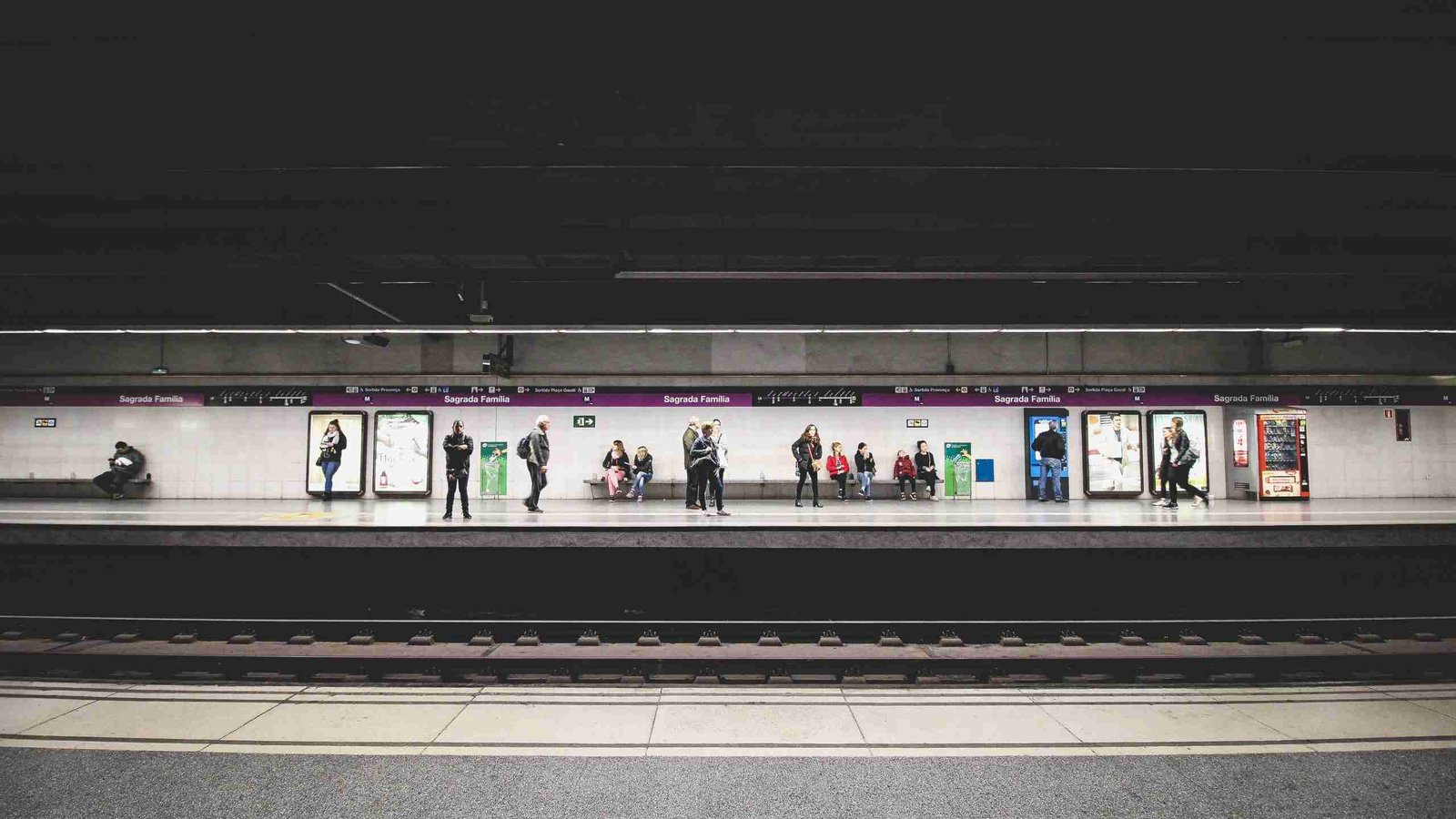
Barcelona Transportation Overview
Metro System
Barcelona‘s Metro system boasts an impressive 12 lines, suburban rail, each identified by a unique color. With 303 stations in operation, the Metro offers extensive coverage across the city. Notably, 8 of these suburban rail lines are equipped with automatic doors for enhanced safety and convenience.
The Metro is a popular choice for both locals and tourists due to its efficiency and connectivity. For instance, Line 4 (Yellow) connects the city center with the beach, while Line 3 (Green) provides access to major attractions like Park Güell and Camp Nou stadium.
Bus Network
In addition to the Metro, Barcelona features an extensive bus network comprising over 1,000 buses that traverse various routes throughout the city. This comprehensive network ensures that even areas not covered by the Metro are easily accessible by public transport.
Moreover, night bus services cater to those exploring Barcelona after dark or returning from late-night activities. The availability of night buses enhances overall mobility and accessibility for residents and visitors alike.
Taxis and Rideshares
Barcelona offers abundant taxi availability, making it convenient for individuals seeking direct transportation or preferring personalized travel experiences. International rideshare companies such as Uber and Cabify operate within the city limits alongside traditional taxi services.
Furthermore, strategically located taxi stands at major attractions ensure easy access to taxis when needed without having to wait or search extensively.
Biking Options
For those inclined towards environmentally friendly modes of transportation or seeking a more active way of getting around Barcelona, dedicated bike lanes crisscrossing the city provide safe passage for cyclists. Moreover, bike rental shops are widely available throughout Barcelona catering to both short-term visitors and long-term residents looking for alternative ways to explore this vibrant metropolis.
Navigating the Metro
Ticket Types
When navigating Barcelona, it’s essential to understand the various ticket types and card available for the metro. For those making a one-time journey, single journey tickets are convenient and can be purchased at metro stations. Occasional travelers may find the T-Casual option suitable, offering ten journeys at a discounted rate. On the other hand, regular commuters benefit from the T-Usual, providing unlimited travel within specific zones over a set period.
Route Planning
To efficiently plan your routes in Barcelona, utilize the TMB app or rely on Google Maps’ integration with public transport routes. The TMB app offers real-time information on schedules and disruptions, ensuring seamless navigation across the city. Detailed route maps displayed at metro stations provide visual guidance for passengers.
Accessibility
Barcelona’s public transport system is designed to accommodate all passengers, including individuals with disabilities. Accessible facilities are available across all modes of transport to ensure inclusivity and convenience for everyone. Furthermore, priority seating is designated for passengers with disabilities while boarding assistance is readily provided upon request.
Safety Tips
While exploring Barcelona via its metro system, it’s crucial to remain vigilant against pickpockets in crowded areas such as tourist hotspots and busy stations. To safeguard belongings during travel, opt for secure bags and keep valuables close at all times. Moreover, when traveling at night, prioritize well-lit and populated routes to enhance personal safety.
Utilizing Buses
Public transportation is essential for getting around Barcelona, and the extensive bus network offers a convenient way to explore the city. With different color-coded bus routes, it’s easy to identify which route to take, and these buses cover the entire city. During peak hours, buses operate frequently, ensuring that passengers can travel without long waits.
At bus stops and stations, passengers can access timetables displaying scheduled departure times. Real-time schedule updates are available online, allowing commuters to plan their journeys more effectively. For late-night travelers, night bus timetables cater to those needing transportation between midnight and 5 am. These services are particularly useful for individuals exploring Barcelona’s vibrant nightlife or working late shifts.
Night buses in Barcelona connect major nightlife areas and operate with frequent services during weekends. This makes them an ideal option for residents or tourists wanting to enjoy the city after dark while relying on safe and reliable public transportation.
To enhance the commuting experience further, several apps provide real-time transit information in Barcelona. The TMB app offers comprehensive details about public transportation schedules and routes, ensuring that users stay informed about any service changes or disruptions. Apps like Moovit and Citymapper facilitate multi-modal trip planning by offering various transit options beyond just buses.
Other Transit Methods
Trams and FGC
Barcelona offers an extensive network of tram lines that seamlessly connect the city to its suburban areas. The Ferrocarrils de la Generalitat de Catalunya (FGC) trains are another reliable option, providing convenient access to nearby towns. Notably, both tram lines and FGC trains are integrated with the city’s metro and bus systems, allowing for a smooth transition between different modes of transportation.
Barcelona presents a modern and convenient alternative for getting around the city. Electric scooter rentals are widely available throughout Barcelona, offering visitors a flexible means of exploring various attractions. It’s important to note that wearing helmets is mandatory by law when riding electric scooters in the city. Visitors should be aware of parking restrictions that apply to these vehicles in certain areas.
Walking Paths
For those who prefer a more leisurely approach to exploration, Barcelona boasts picturesque walking paths that showcase the city’s vibrant culture and history. The renowned Ramblas pedestrian street located in the heart of the city center provides an immersive experience with its lively atmosphere and diverse offerings. Moreover, visitors can enjoy strolling along the waterfront promenade near Barceloneta beach or meandering through the charming historic streets within the Gothic Quarter.
Tickets and Passes
Purchasing tickets is convenient as they are available at metro stations, newsstands, and online. This accessibility ensures that travelers can easily obtain the necessary tickets without any hassle.
Contactless payment is accepted on buses and trams, making the process even more seamless for visitors. The ticket machines also offer multiple language options, catering to the diverse international tourists who visit Barcelona.
Travel cards are another practical option for getting around the city. The Hola Barcelona Card provides unlimited travel across public transport networks within the city. For those looking for a set number of journeys, the T-10 card offers ten trips at a discounted rate. Furthermore, the Barcelona Card not only covers transportation but also provides discounts on various attractions in the city.
Moreover, there are several discount options available for specific groups of travelers. Senior citizens can benefit from reduced fares on public transport services in Barcelona while children under four years old travel free of charge. Families traveling together can take advantage of family travel cards designed to make their journey cost-effective and convenient.
Practical Navigation Tips
Peak Hours
Peak hours in Barcelona are crucial to consider when planning your travels. Mornings, from 7:30 am to 9:30 am, and evenings, from 5:30 pm to 7:30 pm, experience a surge in commuters. During these times, public transportation services tend to be more frequent but also more crowded. To avoid the rush and ensure a smoother journey, plan your trips outside of these peak periods whenever possible.
Navigating during off-peak hours not only saves time but also offers a more comfortable travel experience. For instance, you can explore popular attractions with fewer crowds or enjoy a leisurely commute without the hustle and bustle of rush hour.
Cultural Etiquette
Respecting local customs and traditions is essential when getting around Barcelona. Dressing modestly when visiting religious sites demonstrates cultural sensitivity and respect for the local community’s beliefs. Learning basic Spanish phrases such as “Hola” (hello) and “Gracias” (thank you) can go a long way in fostering positive interactions with locals.
Understanding cultural etiquette enhances your overall travel experience by allowing you to engage with the city’s rich heritage respectfully. By embracing local customs and language basics, travelers can forge meaningful connections with the people they encounter during their exploration of Barcelona.
Language Basics
Basic Spanish phrases like “¿Dónde está el baño?” (where is the bathroom?) can be incredibly useful while navigating through Barcelona. These simple expressions enable travelers to communicate effectively with locals for directions or assistance during their excursions throughout the city.
Day Trips from Barcelona
Regional Trains
Barcelona offers excellent connectivity to neighboring cities through RENFE trains. These trains are ideal for day trips, providing convenient and efficient transportation options. The high-speed AVE trains offer quick access to major Spanish cities, making it possible to explore further afield without spending hours on travel. For those interested in exploring nearby towns, the suburban trains provide an affordable and straightforward means of reaching charming destinations just outside Barcelona.
For instance:
- Travelers can hop on a RENFE train and visit the medieval city of Girona.
- AVE trains allow for day trips to Madrid or Valencia with ease.
- Suburban trains make it simple to explore picturesque towns like Montserrat or Vic.
Private Tours
Private tours offer an enriching way to experience Barcelona’s surroundings. Whether it’s delving into historic neighborhoods, indulging in wine tasting amidst beautiful countryside vineyards, or marveling at the iconic architecture designed by Gaudi, there are various private tour options available. These guided experiences provide insightful narratives and personalized attention while exploring different facets of Catalonia’s culture and heritage.
For example:
- Visitors can join a walking tour that explores the architectural wonders created by Antoni Gaudi.
- Wine enthusiasts can partake in a guided tour through Penedès wine country for tastings.
- History buffs might opt for a private excursion uncovering the secrets of ancient Catalan villages.
Coastal Towns
Barcelona’s proximity to captivating coastal towns allows travelers to enjoy diverse experiences within easy reach. From the charming allure of Sitges with its beautiful beaches to Calella de Palafrugell renowned for its stunning coastal landscapes and Tarragona offering glimpses into Roman history alongside picturesque coastlines, there is no shortage of delightful seaside escapes waiting just beyond Barcelona’s borders.
Notable examples include:
- Exploring Sitges’ vibrant beachfront promenade lined with cafes and boutiques.
- Relaxing on Calella de Palafrugell’s pristine beaches surrounded by crystal-clear waters.
- Discovering Tarragona’s well-preserved Roman amphitheater overlooking the Mediterranean Sea.
Accessibility in Barcelona
Facilities Access
Barcelona boasts accessible facilities at major tourist sites, making it easier for travelers with mobility challenges to explore the city. From iconic landmarks like Sagrada Familia to cultural attractions such as Park Güell, visitors can expect wheelchair-friendly entrances and pathways. The city ensures that accessible restrooms are available throughout, ensuring convenience for all tourists.
For example, famous sites like Casa Batlló and La Pedrera have implemented measures to accommodate individuals with disabilities. These efforts contribute to a more inclusive experience for all visitors.
Assistance Services
Travelers with special needs can rely on special assistance services when using public transport in Barcelona. Whether it’s navigating the metro system or boarding buses, individuals requiring extra support can access designated services provided by transportation authorities. Moreover, tourist information centers offer valuable support and guidance to ensure a seamless travel experience for everyone. Emergency service contact numbers are readily available as an added safety measure.
One notable example is TMB (Transports Metropolitans de Barcelona), which offers comprehensive assistance services across its network of buses and metro lines.
Accessible Routes
The city center of Barcelona features wheelchair-accessible routes, allowing individuals with mobility impairments to move around comfortably. Parks and gardens also provide accessible paths so that everyone can enjoy the natural beauty of these spaces without limitations. Ramped access is prevalent in public buildings across the city, further enhancing accessibility for all residents and visitors alike.
An excellent instance is Parc de la Ciutadella, which offers paved paths suitable for wheelchairs and strollers amidst lush greenery.
Money-Saving Strategies
When getting around Barcelona, consider investing in tourist passes like the Barcelona Card, which offers free access to public transport. The City Sightseeing Pass provides convenient hop-on-hop-off buses, allowing you to explore various attractions at your own pace. Moreover, the Articket BCN gives you access to multiple museums and cultural sites with a single pass.
To avoid crowds and make the most of your time, opt for off-peak travel. Mid-morning or mid-afternoon trips can help you steer clear of rush hour congestion while enjoying quieter attractions during less busy times. Reduced traffic outside peak hours also means smoother journeys across the city.
Consider purchasing combo tickets that offer combined entry to popular attractions along with transportation options. These packages often come with discounted rates for multiple experiences and may include perks such as a metro pass when visiting iconic landmarks like Sagrada Familia.
Frequently Asked Questions
How reliable is the public transportation in Barcelona?
Barcelona’s public transportation, including the metro and buses, is generally reliable and efficient. The city has a well-connected network that can take you to most major attractions and areas of interest.
What are some practical navigation tips for getting around Barcelona?
It’s best to familiarize yourself with the metro lines and bus routes beforehand. Consider using mobile apps like Google Maps or Citymapper for real-time transit information. Keep an eye out for signage and be mindful of pickpockets in crowded areas.
Are there any money-saving strategies for using public transport in Barcelona?
Opting for multi-day travel cards or passes can save you money if you plan on using public transport frequently during your stay. Also, consider walking or biking when exploring nearby areas to cut down on transportation costs.
How accessible is Barcelona for individuals with mobility challenges?
Barcelona has made significant efforts to improve accessibility, with many metro stations equipped with elevators and ramps. However, it’s advisable to check specific attractions’ accessibility beforehand as older parts of the city may have limitations.
What day trips are recommended from Barcelona via public transportation?
Popular day trip options include visiting Montserrat, Sitges, Tarragona, or Girona—all easily reachable by train from Barcelona. Each destination offers its own unique charm and provides a delightful escape from the bustling city life.



